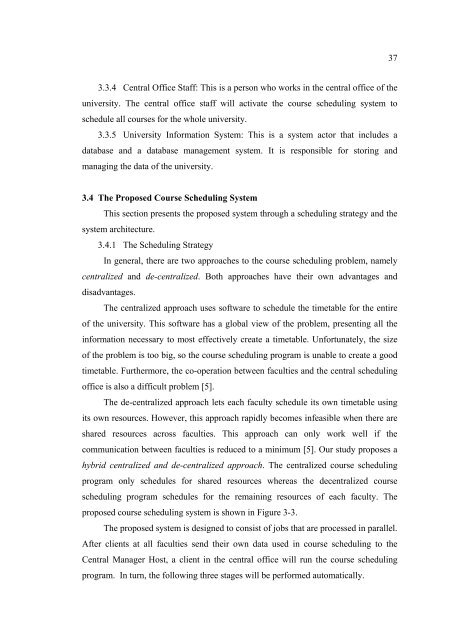a multi-objective bisexual reproduction genetic algorithm for ...
a multi-objective bisexual reproduction genetic algorithm for ...
a multi-objective bisexual reproduction genetic algorithm for ...
You also want an ePaper? Increase the reach of your titles
YUMPU automatically turns print PDFs into web optimized ePapers that Google loves.
37<br />
3.3.4 Central Office Staff: This is a person who works in the central office of the<br />
university. The central office staff will activate the course scheduling system to<br />
schedule all courses <strong>for</strong> the whole university.<br />
3.3.5 University In<strong>for</strong>mation System: This is a system actor that includes a<br />
database and a database management system. It is responsible <strong>for</strong> storing and<br />
managing the data of the university.<br />
3.4 The Proposed Course Scheduling System<br />
This section presents the proposed system through a scheduling strategy and the<br />
system architecture.<br />
3.4.1 The Scheduling Strategy<br />
In general, there are two approaches to the course scheduling problem, namely<br />
centralized and de-centralized. Both approaches have their own advantages and<br />
disadvantages.<br />
The centralized approach uses software to schedule the timetable <strong>for</strong> the entire<br />
of the university. This software has a global view of the problem, presenting all the<br />
in<strong>for</strong>mation necessary to most effectively create a timetable. Un<strong>for</strong>tunately, the size<br />
of the problem is too big, so the course scheduling program is unable to create a good<br />
timetable. Furthermore, the co-operation between faculties and the central scheduling<br />
office is also a difficult problem [5].<br />
The de-centralized approach lets each faculty schedule its own timetable using<br />
its own resources. However, this approach rapidly becomes infeasible when there are<br />
shared resources across faculties. This approach can only work well if the<br />
communication between faculties is reduced to a minimum [5]. Our study proposes a<br />
hybrid centralized and de-centralized approach. The centralized course scheduling<br />
program only schedules <strong>for</strong> shared resources whereas the decentralized course<br />
scheduling program schedules <strong>for</strong> the remaining resources of each faculty. The<br />
proposed course scheduling system is shown in Figure 3-3.<br />
The proposed system is designed to consist of jobs that are processed in parallel.<br />
After clients at all faculties send their own data used in course scheduling to the<br />
Central Manager Host, a client in the central office will run the course scheduling<br />
program. In turn, the following three stages will be per<strong>for</strong>med automatically.













